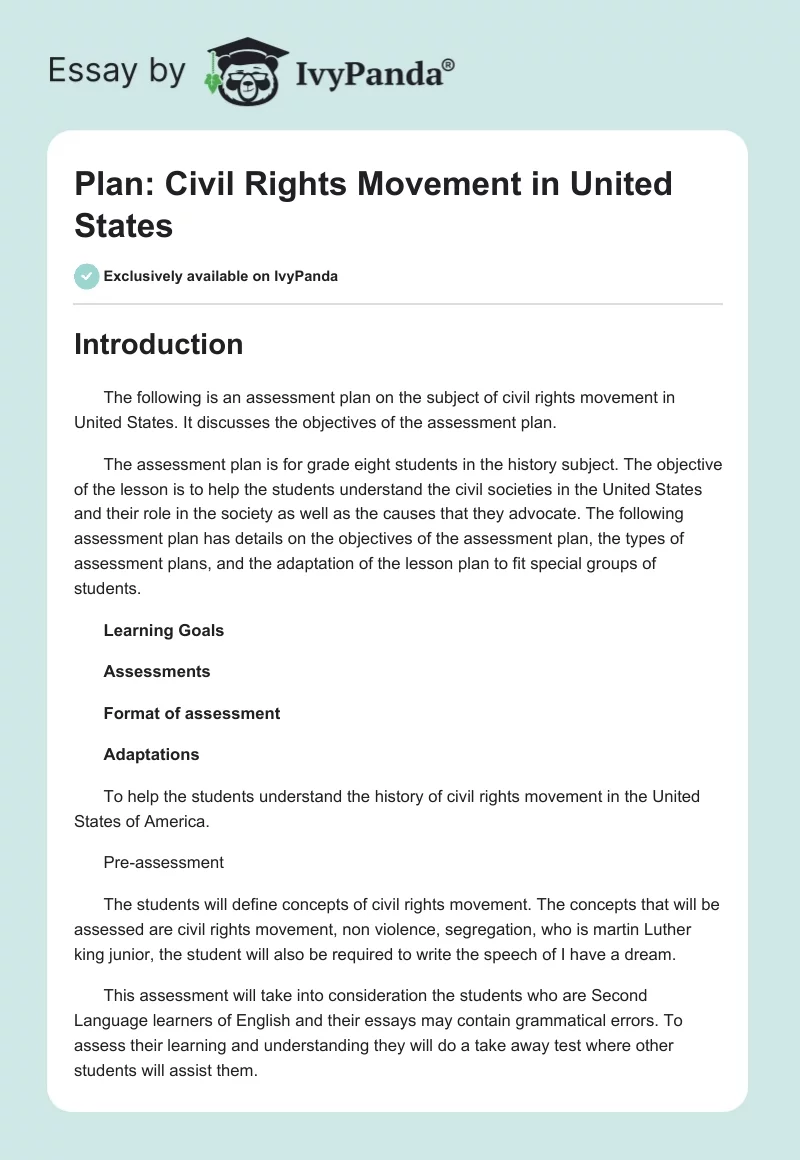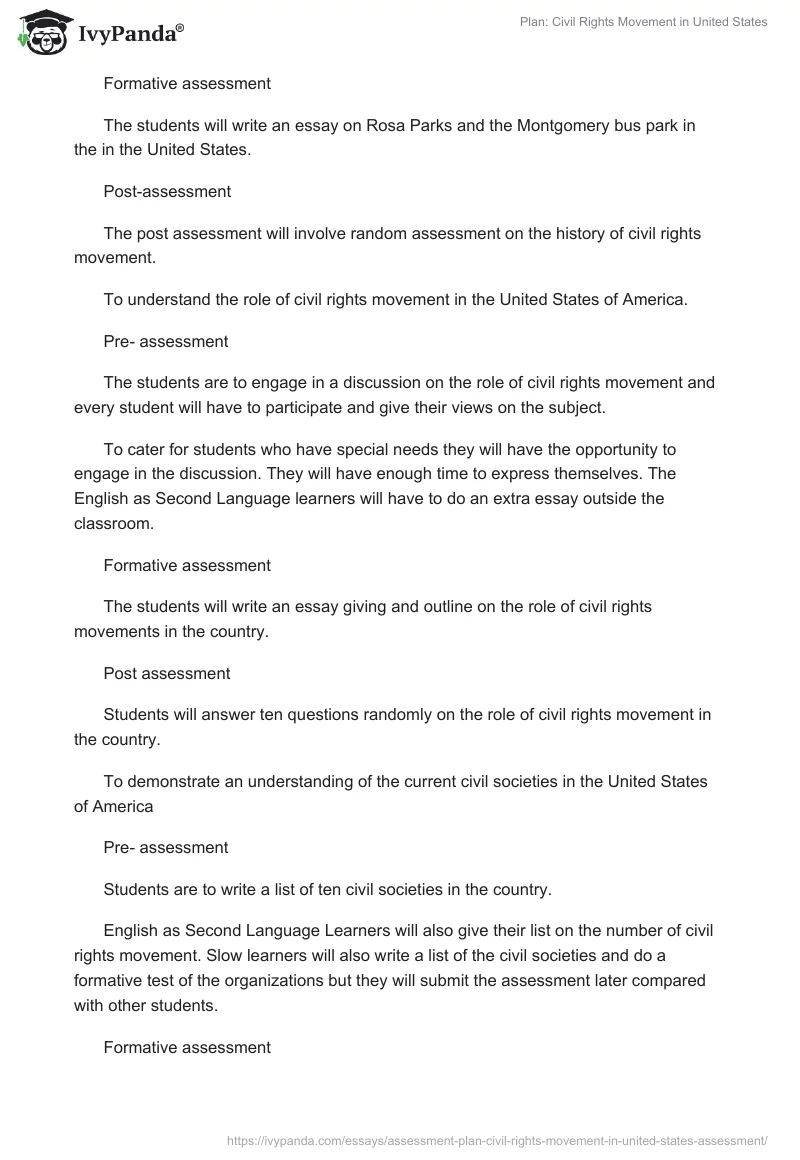Introduction
The following is an assessment plan on the subject of civil rights movement in United States. It discusses the objectives of the assessment plan.
The assessment plan is for grade eight students in the history subject. The objective of the lesson is to help the students understand the civil societies in the United States and their role in the society as well as the causes that they advocate. The following assessment plan has details on the objectives of the assessment plan, the types of assessment plans, and the adaptation of the lesson plan to fit special groups of students.
Overview of the assessment plan
The following is an explanation of the lesson plan. The first discussion is on the objectives of the assessment plan. To create a holistic lesson plan one has to know the purpose as well as the aim of the assessment. The assessments are rubrics designed to measure whether the students have comprehended the topics of the subject taught.
They measure the lesson objectives and the learning outcome. They help the teacher to know whether the students have understood the topic or subject of learning. They also enable the teachers to assess students’ performance against the learning outcomes stipulated in the lesson plan.
This assessment plan has four learning outcomes to achieve. The first one is to help the students know the history of civil rights movement. The second one is to assist the students know the role of civil rights movement in the United States of America. The third learning outcome for assessment is the knowledge about the existing civil rights movement. The other objective of the assessment test is to assess the student’s knowledge on the causes advocated by civil rights movement.
The assessment plan authentically measures the students’ knowledge on the subject, the performance as well as achievement of the learning outcomes in three major ways. The first one is conducting a pre assessment that concerns a particular learning outcome. The pre assessment gauges the students’ previous knowledge on the subject so that the teacher can know what to teach.
The pre assessment in this case will inform the teacher on what the students know about civil rights movement to assess whether they have gained new knowledge on the subject or not. The other way of assessing the performance and the learning outcomes is through the formative assessments. The formative assessment will assist the teacher assess the students understanding and comprehension capability as the teaching continues.
Formative tests assess the comprehension of the subject and the student’s knowledge on the subject (Swan, 2005). The above assessment plan has four-assessment test with each test assessing the achievement of each learning outcome.
The other assessment test is the post assessment, which measures the student’s comprehension and it is very imperative as it indicates whether the students have retained knowledge on the subject. It further helps to compare and assess whether there is improvement in the student by comparing the pre assessment and post assessment results (Dole & McIntosh, 2005).
To make the assessment plan effective such that it caters for special group of students who when measured using the normal rubrics may be disadvantaged as their learning may be different from the rest of the students. The adaptation of the assessments caters for the students who are English as second language learners and may have problem in expressing their points appropriately. The second group of students is the slow learners.
This is a group of students whose rate of comprehension of facts is different or slower compared to the rest of the students. These groups may need different forms of assessment to cater for their learning. This assessment plan caters for them by having them work in groups. In case of individual tests, they should be given more time than the rest of the students.
Late submission of tests from this group of students is allowed when testing outside the classroom assessments. The other group is the quick learners who learn and understand concepts quickly and easily compared with other students. To cater for this group of students the teacher will assign them extra assignments and questions. The teacher can also use them to assist the slow learners as well as the ESL students (Dole & McIntosh, 2005).
The following are the assessments used in the above assessment plan to measure the student’s ability in achieving the learning outcome. The first pre assessment measures the students’ knowledge on the pre assessment and the knowledge on definitions of terms of the civil rights movement of 1960. The objective is to assess whether the students have any knowledge on the history of the civil rights movement.
The other assessment requires the students to write an essay on Rosa Parks a prominent figure in the civil rights agitation in the late 1950’s. This will assess whether the students have leant anything concerning the civil rights movement. In aligning the second objective with the learning objectives the second set of assessments were on the role of civil rights movement. The pre assessment involves a discussion on what the students thought about the role of civil rights movement.
Each student was to give a different answer from what others have mentioned in order to promote critical thinking and assess the students’ prior knowledge. The formative test writing an essay on the role of civil rights movement once the lesson is over. This is to test their comprehension. The post assessment will involve the students answering a list of ten questions on the role of the civil rights movement (Sweller, 1994).
The other learning outcome is helping the students have knowledge of the current civil societies in the country. The pre assessment will involve having the students writing a list of the civil rights group they know about in the United States. The formative test will involve the students writing an essay of three civil societies in the United States of America. In the test, they will have to describe the year of formation, the causes they advocate for and the leaders of that organization.
The post assessment in this learning outcome will involve the students discussing the causes of different civil rights groups in the country. The fourth learning outcome involves aligning the fourth learning objective with the necessary assessments. The pre assessment involves having the student demonstrate previous understanding of the causes that civil rights movement advocates (Swan, 2005).
The formative assessment will have the students pick up one cause of the civil rights movements such as gay rights, women rights, and minority rights and then discuss the origin of the agitation of that cause as well as factors, which led to the formation of such movement. This test will be done in groups of five students. The post assessment will involve having each of the student answering individual questions on the issues that different civil rights groups address (Sweller, 1994).
To measure the learning outcomes, the assessment plan will have rubrics that will measure the students’ performance. This involves having a standard that shows that the students have understood what they have learnt or the teacher has to repeat some basics that the students may have misunderstood. The formative assessments will provide feedback to the teacher concerning the students’ comprehension ability. They will also help the student realize area where the performance is high or low (Dole & McIntosh, 2005).
Conducting the assessments without having an appropriate record keeping system for the student’s performance will be inappropriate. The teacher will have a recording system where performance of the students will be documented (Swan, 2005).The records must take into consideration the special groups of students. The records make it easy for the teacher to evaluate the students and know their range of capabilities.
The recording also assists the teacher to have feedback on the teaching methods and know whether they are appropriate or not. The records also help the teacher to measure whether the lessons have attained the state learning objectives or not. When recording, it is imperative to take note of other factors that helped the students understand the subject. Taking notes on whether the students learnt from textbooks or their parents may help in formulating better teaching and assessment strategies (Sweller, 1994).
The analysis of the data collected from the test is very imperative. The assessments provide the teacher with data about the students. This data may help in showing the best students, weak student and students who need special attention. The data from the assessments also helps the teacher to compare the students with other institutions and other classes (Dole & McIntosh, 2005).
When formulating the assessment plan it is imperative to consider the instructional setting, which will be a classroom setting. The classroom will have computers from where the students can access information online but social media sites are blocked. The students have the permit of using computers when the teacher is not in class for research and study purpose. The students also have accesses to the books from the school library.
The instructional setting is imperative as it influences the type of assessment concerning the students’ access to information and the learning materials (Thompson, 1999). The assessment plans should have adaptations to measure the appropriate learning methods against the test scores of the students. The assessments should test whether the students perform better when assessed using essays, a list of questions or discussions (Lambdin, Lindquist, Rays & Smith, 2009).
Conclusion
The assessment plans are important in the learning process as without having the assessments the learning process will be incomplete. This is because the teacher will have no standards to measure the students learning against what they know. The assessment plan provides feedback to both the student and the teacher on the comprehension and performance of the subject.
References
Dole, S. & McIntosh, A. (2005). Learning assessment strategies. Hobart: Department of Education Tasmania.
Lambdin, D., Lindquist, M., Rays, R. & Smith, N. (2009). Helping children learn mathematics. New York: John Wiley & Sons.
Swan, M. (2005). Improving assessment plans: Challenges and strategies. Sheffield, England: Department of Education and Skills Standards Unity.
Sweller, J. (1994). Cognitive load theory, learning difficulty, and instructional design. Learning and Instruction, 4, 295-312.
Thompson, I. (1999). Getting your head around mental calculation: Issues in effective assessments. Buckingham: Open University Press.


